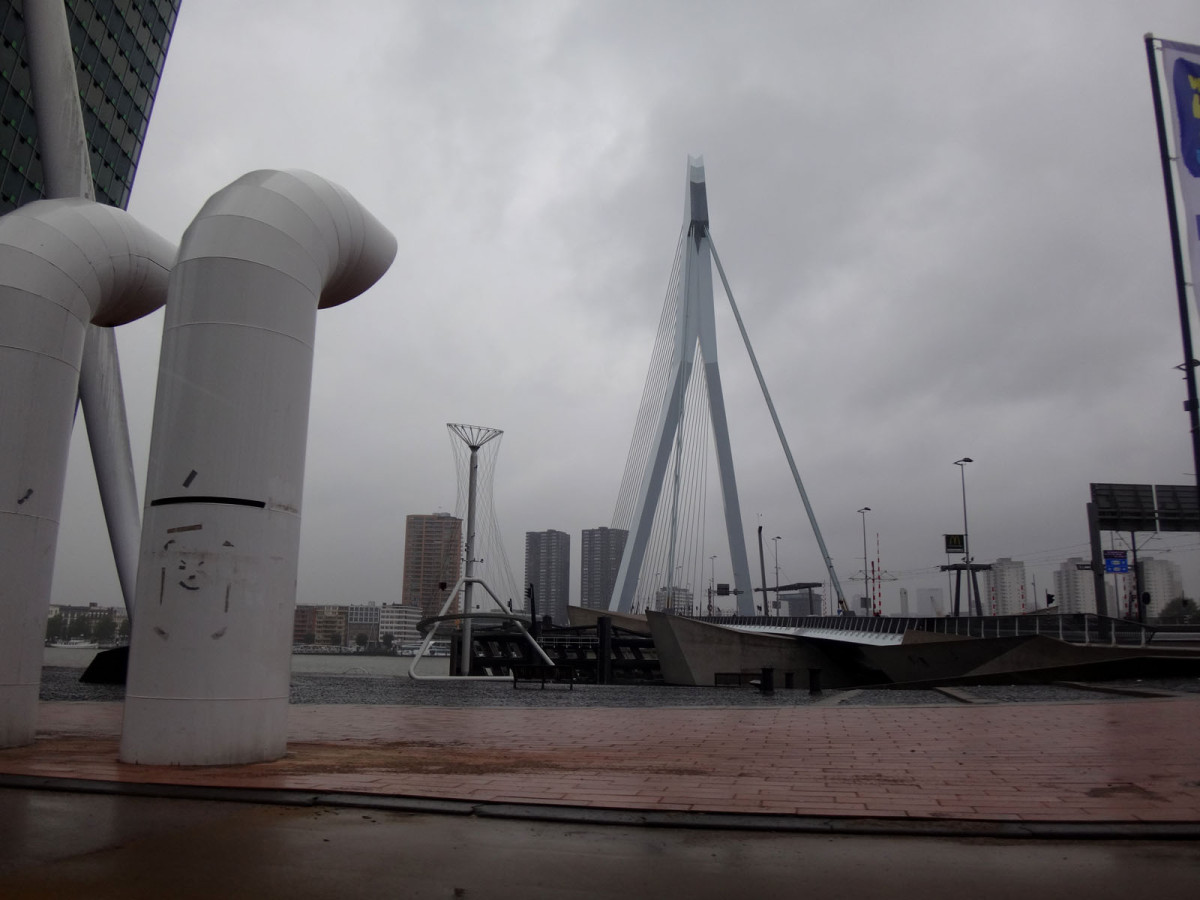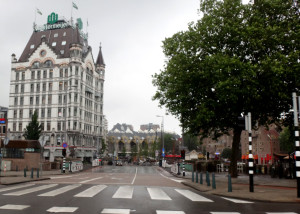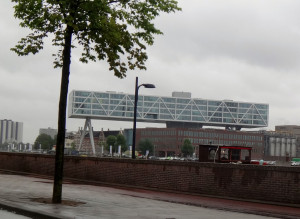You know when you don’t expect to fall in love, and, yet, you do? That was Rotterdam for me. I was expecting a big port city with container ships in the harbor and heavy trucks transporting goods over crumbling streets. Boy, was I wrong. We skipped our planned harbor boat tour because it was pouring rain and chilly. But in a pouring rain, from the enclosure of a small automobile, I slowly fell in love with the whimsy and wonder of Rotterdam.
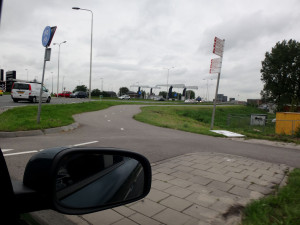
By the way, it wasn’t raining just a little bit – I mean, I’m not a total wimp. It was raining A LOT.
The destruction of Rotterdam
On May 14, 1940, the German Luftwaffe carpet bombed central Rotterdam, killing 900 people. More than 1,000 bombs nearly leveled the city, destroying 24,978 homes, 24 churches, 2,320 stores, 775 warehouses and 62 schools (Roep & Loerakker 1999, p. 42 Square 2.) When the Germans threatened to flatten Utrecht the next day (where I will stay this summer), the Dutch surrendered. This was done in spite of peace treaties and a cease fire. The Germans attacked because they needed the Netherlands as a base to attack England.
Now, 75 years later, the Dutch people have built an extraordinary masterpiece of a city. As we toured Rotterdam, we were slowly drawn in by the imaginative architecture. It’s like the worst had already happened and architects could now take risks to create a vibrant living space for city dwellers and workers. When I returned home, I discovered a wonderful website, Architecture in Rotterdam, that informs part of this blog. The reason I know the names of the buildings — and the history of the buildings — is because of this website. The links I provide below each link up to a page that gives a more detailed description of the buildings.
Rotterdam
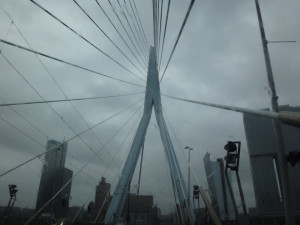


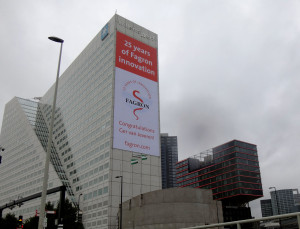

In his book Delirious New York, Rem Koolhaas describes a Manhattan Grid, a city within a city, that springs from the imagination of man and has nothing to do with nature (so take that, Gaudi). This area of Rotterdam houses homes, a hotel, offices — more than 7,500 rooms – and is called, I believe, de Rotterdam. There’s a much better image at Architecture in Rotterdam.
The White House, built about 1900, survived the central city bombing and today is still used as a luxury hotel. You can read more about the White House at Architecture in Rotterdam.


“Since the presentation of the first plan the Peperklip was controversial. Architecture critics described the building as inhospitable, cold and merciless. Others praised the timeless, rational architecture, and saw the building as a liberation from the disastrous small scale. During the first year the building was often in the news, especially because of the many social problems among the residents: (Architecture in Rotterdam).
The hugely popular Cube Houses.

“The Blaak forest contains 38 cubic houses, several shops and three large cubes situated on a pedestrian bridge over the Blaak. It was one of the attempts to enliven the downtown area and to shift the focus from office buildings and traffic flow to housing and recreation. The Cube Houses and buildings around the Oude Haven (Old Port) were designed by the Amsterdam architect Piet Blom (1934-1999), who had previously designed similar experimental housing” (Architecture in Rotterdam).
OK – is this building just too cool for school? We approached the building from many angles but never got close to it as it was always across a river or open water. I think this is the Unilever Best Foods office building.
“The new headquarters of Unilever Bestfoods was built on the site of the Blue Band factory on the northern tip of the district Feyenoord. Because the building was built as a bridge over the existing complex, the nearby site of the former brewery Oranjeboom was kept empty. The Merchant City district (Koopmanstadwijk), planned here, will contain about three hundred houses designed by architects JHK and West 8…Besides a smart idea to save space, the bridge building is a spectacular example of prefabrication. To not to disturb the production of the plant the building was erected 200 meters away on the Oranjeboom grounds” (Architecture in Rotterdam).

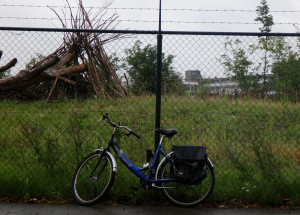
If anything is missing in Rotterdam, perhaps it’s open land for city play. It could be there and I never discovered it. But open land should be readily apparent for residents and tourists, alike.
Market Hall’s parking garage and mini-museum
The Market Hall was at the very top of my list of places to see in Rotterdam. I read about the new building in nearly every magazine I picked up last year and I was determined to visit this place. I was not disappointed. Let’s start with the parking garage.
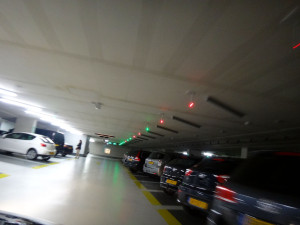

I was surprised to discover a mini-museum of the site in the bowels of the parking garage! Apparently the Market Hall was built upon the ruins of a medieval housing project dating from 1350-1550. Bits of pottery, housing and artifacts were included in the well-documented museum area. Here’s what the sign said:
You are situated in the medieval city of Rotterdam. The city came into existance in approximately AD 1270 when the dam in the river Rotte was constructed in the spot where we now find the Hoogstraat. In the year 1340 Rotterdam was granted city privileges and in 1358 the city further expanded and was surrounded by fortifications. To the south, two polders were added to the city. They ran up to the city rampart at the present day Blook. These are the two medieval housing projects Oostnieuwland and Westnieuwland.
Note: if you say Dutch words out loud, they make sense. For example, say Oostnieuwland out loud and you can hear “East New Land.” Say Westnieuwland out loud and you can hear “West New Land.”
The Markthall is located in the eastern part of the district Westnieuwland. A dike ran around the district with the residences of craftsmen and fishermen constructed on top of the embankment. The archeologists of the municipality of Rotterdam excavated approximately 30 houses that were located on the dike. The houses were made of wood and had thatched roofs. Houses built of stone only appeared in the course of the 15th century.

I love that Rotterdam has their own archeologists. I love that city planning existed in 1340 and cities had to get permission to expand. I thought that cities grew organically but I was wrong: the requirements of daily living necessitated planning and permissions in order to grow and protect a society even 700 years ago. This rocked my head and I had to seriously consider these personal discoveries. My conclusion? WOW. Way to go, ancestors.
The Markthall
The Markthall (try that little trick I wrote about earlier – say it out loud and it makes perfect sense) looks like an impressively dull, concrete bean from the outside. But we entered from the parking garage below the building.

As we rode the elevators upward from the parking garage, we discovered the history of Rotterdam written on timelines inscribed on the sides of the escalators. It was easy to get around thanks to maps posted throughout the site.
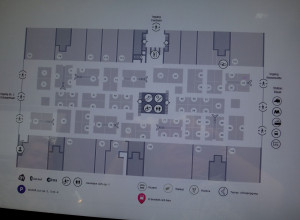

Then we burst upon the main floor and our jaws dropped as we gaped at the massive space topped with a cascade of organic visuals. See all those little squares dotting the ceiling/painting? Those are the windows of people’s apartments – residents look down into the the hub-bub of the market hall.

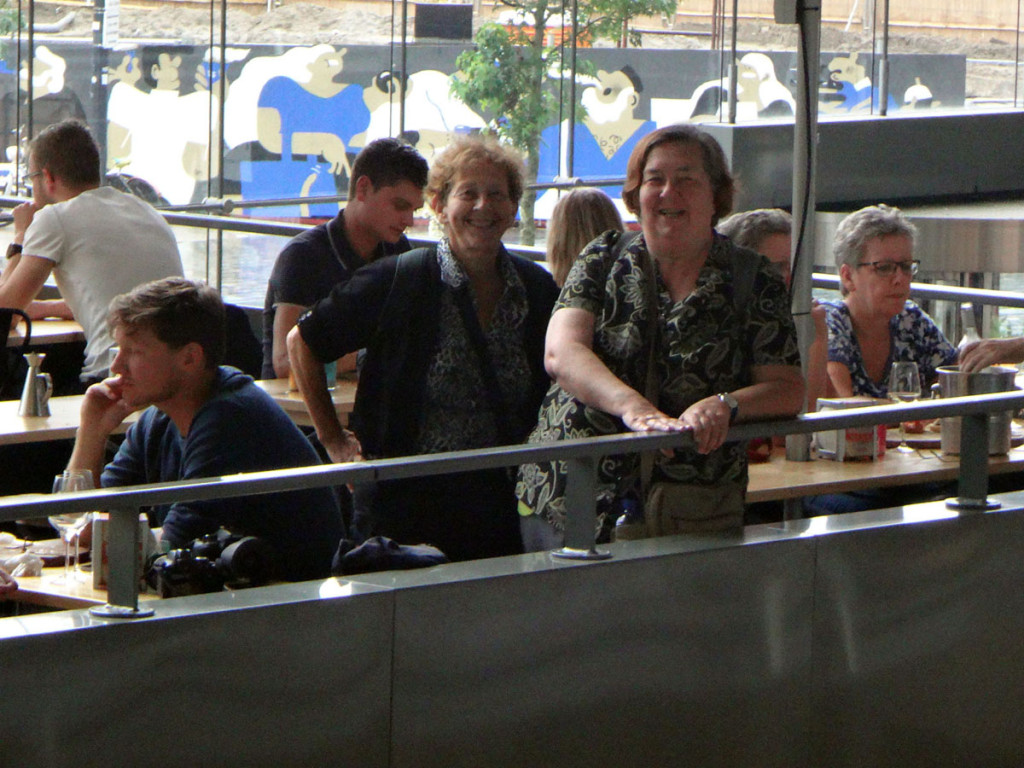
This view is from just above the hall looking out onto a series of individual terraces populated by a variety of restaurants. Each terrace is accessed by an individual stairway. When you dine on one of the terraces, you kind of get the feeling like you are floating in space with a bunch of boats tethered together. I wanted to wave to the other diners like a boat passing at sea.



And here is the heart of the Marketplace: the individual food sellers and restaurants.

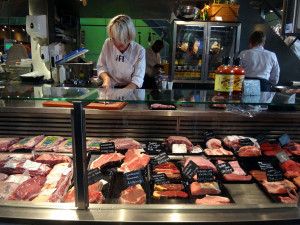
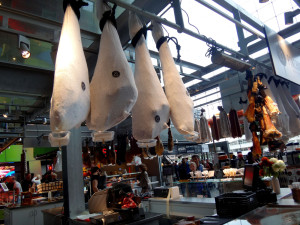








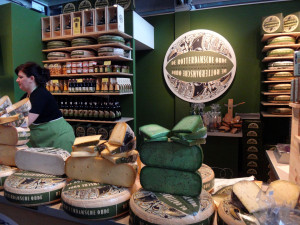
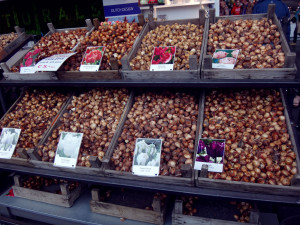
Marktplace restaurants
We chose to eat at a Tapas Bar – great choice! A bit spicy but Maureen was happy with her oysters and I got to eat everything too spicy for Maureen and Rachel. Lucky me.






Technical Problems in the Parking Garage
I tried to use my new chip card in the parking garage and the machine ate it. Remember when I said to read the words out loud and they would make sense? It was pretty easy to understand that “Afgebroken Pas Uitnemen” meant – “you broke the machine, idiot.” So I pressed the little speaker button and said in my very best Dutch. “Helpen! Do you speak English, please?” I didn’t say please in Dutch because it’s alsjeblieft – try saying that out loud. It sounds like, “I just killed your bleating sheep.”

A lovely woman showed up about 5 minutes later, opened up the guts of the machine, tapped a few key commands, and returned my chip card to me along with a paid receipt. I always wondered what the insides of these machines look like – and now you know too. And I said dankjewel.

I will return to Rotterdam this summer. I want to take the harbor tour and I want to walk through the city on a sunny day. So look for a new Rotterdam blog next summer.

